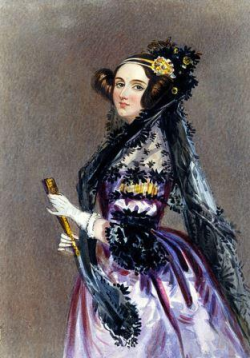Ada Lovelace

- Born
- 10 December 1815
- Died
- 27 November 1852 (age 36)
Ada was the daughter of Lord Byron and Anne Isabella ‘Annabella’ Milbanke. The marriage was not a happy one and when Ada was month old her mother took her to live with her family in Leicestershire. Unusually for the time her father did not insist that she stayed with him, he left England a few months later and she didn't see him again.
Her mother oversaw her education, it was unusual for the time since it concentrated on mathematics and science. Annabella was worried that her father's moody and temperamental behaviour would develop in Ada.
When she was 12, Ada decided she wanted to fly so went about this methodically but also with imagination and passion. She started constructing wings out of various materials and examined the anatomy of birds. She wrote and illustrated a set of notes entitled Flyology.
She was tutored by a number of people including, William Frend, William King and Mary Somerville, a Scottish writer and polymath. When she was 17 her remarkable mathematical abilities began to emerge and this interest in mathematics together with scientific developments remained throughout her adult life.
Ada developed a strong affection and respect for Mary and they corresponded for many years.
It was through Mary that she met Charles Babbage in 1833. Ada was able to see his invention called the Difference Engine which was able to do calculations when a handle was turned. Ada continued to visit Babbage and exchange letters about the potential of his machine and her own studies.
Babbage called her the Enchantress of Numbers. His work was brought to the public’s attention when an Italian mathematician Luigi Menabrea wrote a short paper about his work on his subsequent more complex Analytic Engine. This was published in a Swiss journal in French.
Ada translated this memoir into English but also wrote extensive notes to accompany it. These explained the nature of the Analytic Engine and its differences from the original Difference Engine.
The Analytical Engine weaves algebraic patterns, just as the Jacquard loom weaves flowers and leaves.
Ada Lovelace, Notes on Menabrae’s Memoir on the Analytic Engine, 1843.
Lovelace also gave a method for calculating Bernoulli numbers using the analytic engine, although this machine was never built modern scientists say it would have worked. Was she the first computer programmer?
There have been arguments about how much Lovelace contributed to early computing but what is without question is that she predicted the potential of computers to perform tasks more complex than simple arithmetic. She often integrated poetry and science, her ideas examining how individuals and society can relate to technology.
In 1835 she married in William King who later became the Earl of Lovelace. They had three children and shared many interests. He supported her academic interests and they moved in a London Society which included Michael Faraday and Charles Dickens.
Lovelace suffered from ill health throughout her life and died aged 36 of uterine cancer. She is buried in Hucknall, Nottinghamshire next to her father.
Her contributions to computer science were rediscovered in the 1950s when her notes were republished by B.Y.Bowden. The US Department of Defense named a computer language Ada.
Ada Lovelace Day in October is an international celebration of the achievements of women in STEM subjects.



